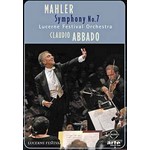
Mahler: Symphony No. 7 (recorded in 2005)
 $46.00
Out of Stock
$46.00
Out of Stock6+ weeks add to cart
GUSTAV MAHLER
Mahler: Symphony No. 7 (recorded in 2005)
Lucerne Festival Orchestra / Claudio Abbado
[ EuroArts DVD / DVD ]
Release Date: Monday 19 June 2006
This item is currently out of stock. It may take 6 or more weeks to obtain from when you place your order as this is a specialist product.
 Suitable for General Audiences
Suitable for General Audiences
G :-
"One day the Lucerne concerts will be appreciated for their role in developing Mahler performance practice"
(MusicWeb Recording of the Month June 2006)
G :-
All Regions - Widescreen 16:9 - PCM Stereo / Dolby Digital 5.1 Surround / DTS 5.1 Surround - Colour - 78 Minutes - NTSC
"Music is a language without words. The equivocal nature of Mahler's Seventh Symphony makes performers respond in an individual way. It is as if Mahler is setting a challenge that will separate the creative from the conformists. In the same way, it is a challenge for listeners. Can they follow the interpretation? Can they feel what the performer is trying to express? There are no "right" answers: the challenge is in the process. As E.M. Forster said, "Only connect". Sometimes when I listen to this symphony I think of Mahler with his uncompromising intellect and originality, looking at us, with a grin, whispering "Only connect".
What then is Abbado expressing? This version has the conductor working with the Lucerne Festival Orchestra, an orchestra hand-picked from among the finest musicians in Europe. The great names are here - Kolja Blacher, Antonello Manacorda, Albrecht Mayer, Sabine Meyer and her Bläserensemble, members of the Hagen and Alban Berg Quartets, members of the Mahler Chamber Orchestra. Abbado has worked with them individually and collectively many times, and they know each other well. Coming together to play is an exhilarating experience, all the more stimulating because it is a seasonal event, rather than a regular fixture. This gives the performance a wonderful blend of precision and spontaneity: these are musicians at the peak, technically, playing for the sheer enjoyment of being together and sharing their love of the music. This means Abbado can create an unusually acute, chamber-like performance.
It is the refinement and sensitivity of this interpretation that is refreshing. Abbado recorded this in May 2001 with the Berlin Philharmonic, when he was their chief conductor. That performance was assured and expansive, making the most of the Berliners' feel for the grand scale. Although many of the Berlin players are on the Lucerne Orchestra too, Abbado has chosen a very different, more sophisticated approach. The famed figure on posthorn that signals the opening asserts itself, but leads naturally into the ensemble, without overly dominating. This chamber approach enhances details like the flurries in the exposition, warning, perhaps, of "night winds" to come. What is even more striking, though is the expert precision with which these players respond to the conductor. They switch from the march theme to strings as if they were a single organism. Playing of this calibre is exciting, particularly when you appreciate just how many players are involved. Abbado takes the march theme not as a rigid militarist march but as something crisper, and faster paced. It is less tied to 19th century reality, and becomes more abstract, more timeless. In the first Nachtmusik, the horns are exquisite, expressly like alpine horns ushering in nightfall. The movement has a duality like that between night and day, darkness and light. Yet, as in the first movement, the music moves forward to the scurrying sounds of clarinets and pizzicato strings. The swirling motifs in the Scherzo cut off with breathtaking suddenness. They deliberately unsettle any complacency. This same unsentimentality illuminates the second Nachtmusik. Serenading mandolins and guitars are typical Romantic cliché. Yet again, this orchestra lifts the movement out of the 19th century with its clean, modern sound. Lush, resonantly mysterious playing is a given, but then Abbado puts finger to mouth, indicating gradual silence. The music softens into a strange, but convincing combination of understated yet precise playing.
In contrast, the Rondo Finale is even more electric. In his notes to the recording, Donald Mitchell states: "The violent, unprepared contrast is akin to parting the curtains in a dark room and finding oneself dazzled by brilliant sunlight". It's an ambiguous, contradictory movement, but what stands out is its powerful sense of energy. This is where a crack orchestra like this proves its worth. The precise, vivid commitment of this playing carries all with it. This is its excitement. There's no place here for sloppy blurred playing. There is no need for the composer to resolve the ambiguities of the night, which are part of nature. Mahler throws himself into the light as if in an act of faith. The Lucerne Orchestra explodes with sheer exhilaration. It's glorious. Abbado shines with happiness and clutches his chest - an unconscious gesture, but one which for me was incredibly poignant. Life is fragile, but Mahler lived it fully and passionately. He wrote the equivocal Nachtmusiks before the rest of the symphony. Perhaps then the Finale is, like Urlicht in the Second Symphony, or the Finale in the Eighth, a statement of faith in life itself? I don't know. But this performance certainly had me thinking on new lines, the sign of a truly original and thought-provoking interpretation. One day, perhaps, when audiences become more attuned to modern approaches to Mahler, the Lucerne Festival concerts will be appreciated for their role in developing Mahler performance practice."
(MusicWeb Recording of the Month June 2006)